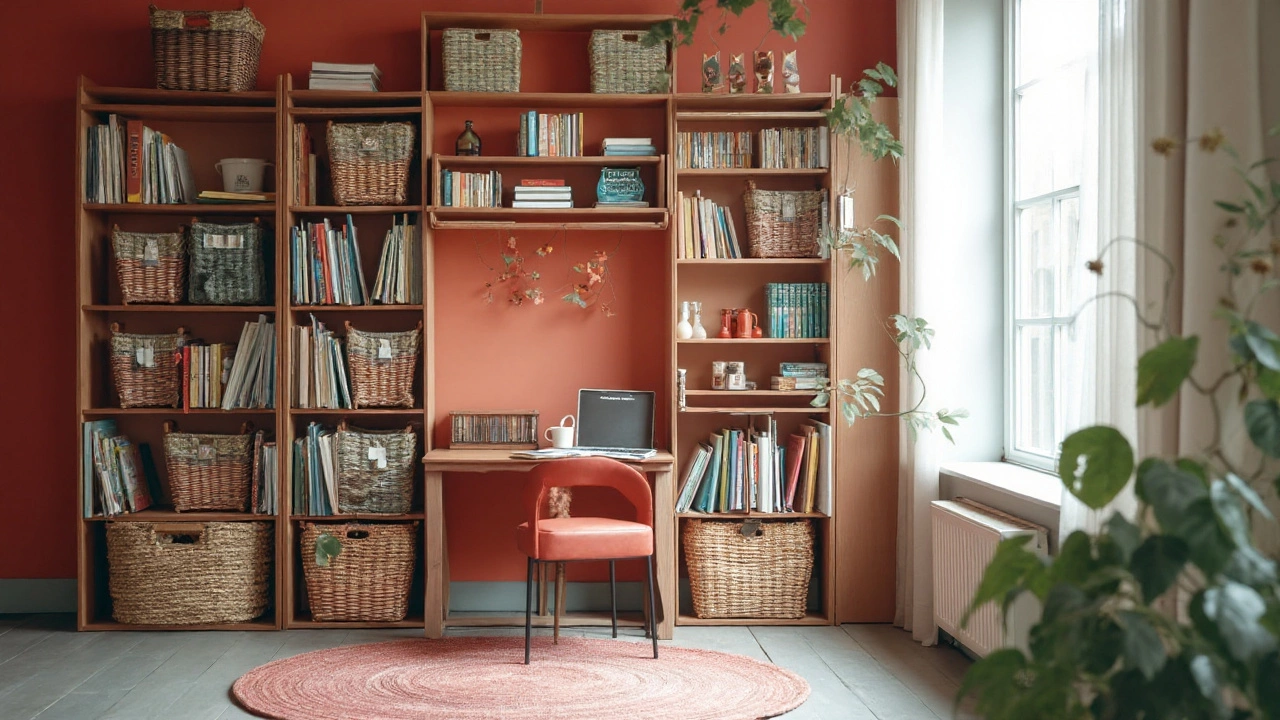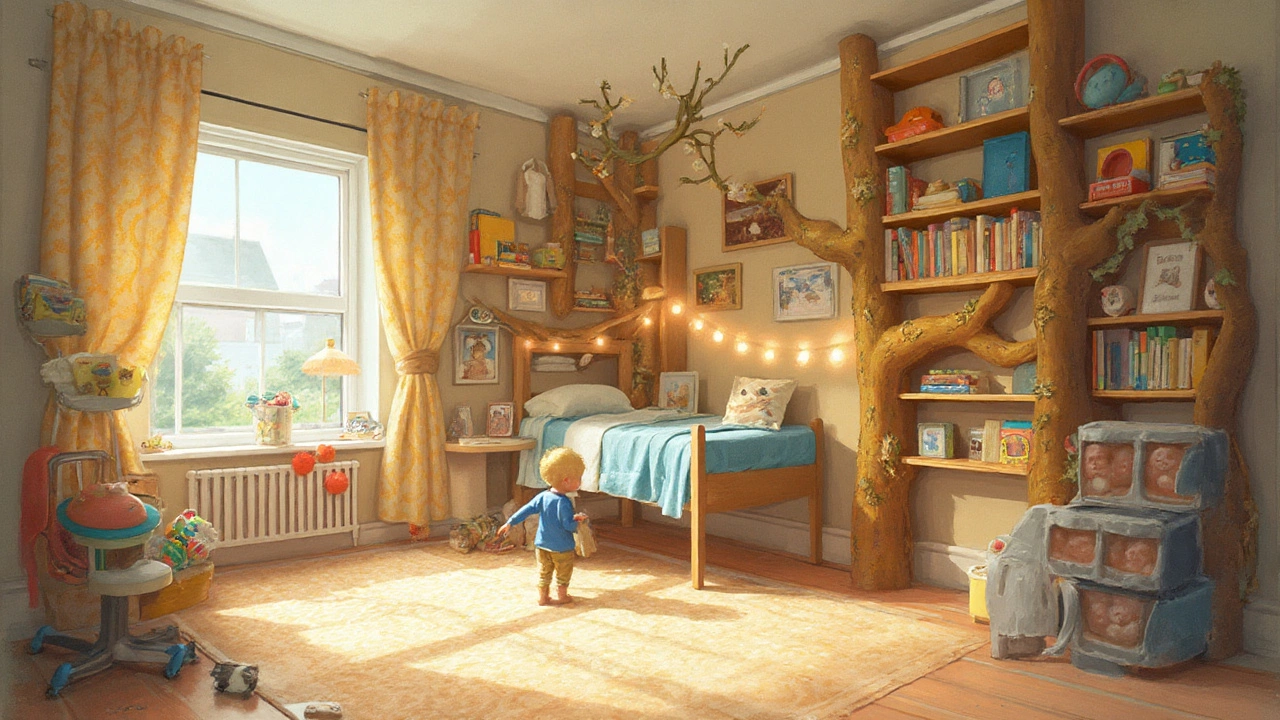If you think bookshelves are just for stacking novels straight from your high school reading list, think again. Bookshelves are like the unsung heroes in any room—do them right, and the whole space feels smarter and more put together. But throw stuff on there willy-nilly, and, well, you end up with a hot mess that even my cat Luna wouldn’t bother to nap on. Rules? Yeah, there are a few. But the good news is, following them doesn’t mean your room looks like everyone else’s. Turns out, the best bookshelves show off who you really are—whether you’re all about the thrillers, plants, family photos, or even your dog Milo’s favorite chew toy (hopefully clean).
Principles of Placement and Proportion
Start with a big question: where do you actually want your bookshelf? Sounds simple but I’ve seen people cram giant shelf units behind doors or underneath slanty attic ceilings just because that’s where the old owners put it. Aim for a wall with good visibility—this is your backdrop, your style statement, your chance to flex a little personality. Bookshelves shouldn’t block windows, heat vents, or outlets—nothing kills a cozy reading vibe faster than standing up and smacking your ankle on a hard edge just to plug in your phone.
Scale really matters. A tiny shelf in a huge living room just looks lost. Go big with a wall-to-wall shelf if you can, or use two shorter ones and keep them together as a set. If ceiling height is on your side (think more than 8 feet), run shelves up high so you can use all that vertical space, and show off those hardcover art books you swear you’re going to read someday.
Ever notice how the fancy decorated bookshelves in hotels or magazines always seem to have breathing room? There’s a trick to it. Interior designers recommend using roughly 60% books, 40% decorative objects. That gives your shelves the Goldilocks touch—not too packed, not too empty. The 60/40 rule is a solid base, but don’t treat it like gospel. Sometimes Luna will nap right in the empty spot and the shelf still looks perfect, as long as there’s space to let the eye rest.
Here’s an interesting stat from a 2023 Home Organization Council survey: 72% of people say that uncluttered, balanced shelves make them feel calmer at home. There’s something deeply satisfying about that meeting point between order and personality. Proportions also extend to what you put on your shelf—a couple of tall items can make things look dynamic, while rows and stacks of the same size can all blend together and disappear.
Lighting is important, too. If your shelf is tucked into a dark corner, add a small lamp or some LED puck lights underneath each shelf. Not only can you actually find that cookbook you swear you own, but the lighting draws attention to the shelf set-up itself. For fans of stats: according to a recent Houzz Design Trends report, shelves with built-in lighting have become 48% more popular in the past two years. A simple stick-on light goes a long way for showing off your best titles.
So, choose the right wall. Use shelves that fit your room’s size—not too tiny, not dwarfing everything else. Balance your books and objects. And don’t ignore the lighting, unless you enjoy reading in the dark with a flashlight in your teeth like you’re in a spy movie.

Organizing, Styling, and Layering Your Bookshelves
If you’re tired of the straight-line book parade, don’t worry. There’s more than one way to stack a shelf. Professional stylists swear by a mix of horizontal and vertical stacks—turn a few books on their sides and use the pile as a stand for a little plant or a favorite photo. The classic vertical row, with all the book spines facing out, looks sharp and neat, but can feel stiff if you do it for every shelf. Try for a blend: some standing, some stacked, some angled slightly if you’re feeling rebellious. This gives your eyes little landmarks as they travel from shelf to shelf.
Decorative items work best when you group them in odd numbers. Three vases, five framed photos, one epic dinosaur figurine (especially if you live with kids, or grown-up kids like me). Odd-numbered groups look more intentional and less fussy to our brains. For shelves that feel modern without turning cold, use a mix of materials. Books, sure, but also ceramics, glass jars, baskets, wood objects, even a stone or two picked up from that memorable beach trip—or the park down the street if you’re low on travel miles.
Don’t overlook negative space. That’s a designer word for “blank spots.” Let empty room exist between items—shelves need space to breathe, just like Milo needs space for his zoomies.
Layering is where real shelf-nerds have fun. Try putting a small framed photo in front of a row of books, or lean artwork along the back edge for depth. This little trick makes shelves look like they’ve been collected over time, not staged overnight for an open house. For plants, trailing vines like pothos or string of hearts look fantastic draped off high corners, but avoid crowding the leaves up against the ceiling—plants and books both love air flow. Be sure to use saucers, unless you like water rings more than your paperbacks.
For people who love color coding: you do you. Rainbow shelves have been trendy for a while, and if arranging by color brings you joy, go for it. Just don’t stress if spine colors don’t match. One survey from Organized Interiors found that 36% of book lovers prefer to group by topic, not color, because it’s easier to locate a mystery or memoir when the mood strikes. The best shelf system is the one you actually use, not just the one that photographs well.
Now, practical tip for pet owners: leave the lowest shelf open or fill it with heavier, non-breakable items. Milo has knocked over his fair share of picture frames in his quest for squirrel-watching territory. Reserve the fragile stuff for anywhere above wagging-tail-height. Same goes if you have little kids. Swap out breakables for soft stuff down low—think baskets for toys, plushies, or even those magazines you keep meaning to read and recycle.
This table summarizes common bookshelf arrangement methods and typical use cases:
| Arrangement Method | Benefits | Where It Works Best |
|---|---|---|
| 60/40 Books-to-Objects | Balanced, not cluttered | Living rooms, home libraries |
| Odd Number Groupings | Visually interesting | Accent shelves, personal displays |
| Mix of Heights | Adds energy and movement | Large or open room dividing shelves |
| Layered Depth | Warmth, curated look | Hallways, entry shelves |
| Color Coding | Fun, organized feel | Bedrooms, home offices |
Finally, handle the dust. Books get dusty fast, especially if you’ve cracked a window recently. Vacuum with the brush attachment or wipe down with a barely-damp cloth at least once a month. You don’t want to discover your cookbook collection is just a flavor delivery system for cat fur and household fuzz.

Advanced Tips, Common Mistakes, and Signature Moves
Ever wonder why certain shelves feel weirdly off, even if technically all the rules are right? One reason is symmetry overload or lack of a focal point. Symmetry is nice, but too much can make a room look stiff. Instead of mirroring each side exactly, try shifting the balance—maybe a tall vase on one side, a pair of mid-rise speakers on the other, and something wild in the middle. It’s like how Luna always finds the tiny sunbeam instead of the center of the carpet—unexpected balance just makes sense.
Here’s a common mistake: cramming every shelf to the brim because you think empty space looks wasteful. Actually, letting the shelf breathe makes everything stand out more—like how art galleries use blank walls. Also, watch your shelf depth. Most books are between 5 and 9 inches deep, but some shelves go way deeper. Stacking two rows of books might sound efficient, but you’ll end up forgetting what’s in the back row, and nobody needs that "where’s my copy of Dune!?" panic (I’ve been there more times than I can admit).
Anchoring is another pro move. The bottom shelf can hold heavier stuff—storage baskets, chunky photo albums, board games. This acts as a visual and literal anchor, keeping tall shelves from feeling top-heavy. And don’t be afraid to leave the top shelf partly empty or use it for simple, bold objects—a fancy vase, a cool sculpture, something with height that draws the eye up, especially if you’ve got high ceilings.
Switch things up seasonally. Nobody says bookshelves are permanent. In summer, swap in more plants and light-colored decor; in winter, cozy them up with candles or fairy lights. Refreshing the look makes the space feel new and lively, and if you’re like me, it’s a great excuse to dust everything and maybe discover a magazine—or cat toy—hiding behind the classics. You know who you are, Luna.
Another mistake to avoid: ignoring shelf weight limits! Cheap shelves bend, and even sturdy ones have their limits. Check your manufacturer’s guidelines or play it safe—heavier hardcovers and encyclopedias should go lower; lighter paperbacks and decorative items can sit up top. Snap a shelf and you’ll be telling that story for years, not in a good way.
You don’t have to spend a fortune to get a magazine-worthy look. Hit up thrift stores for picture frames, small ceramics, quirky bookends (Milo-shaped, if you’re lucky), or even baskets. Sometimes all it takes is moving things around and maybe adding a $3 plant from the supermarket.
Finally, the best signature for your bookshelf? Include some of your story. Tuck in souvenirs from trips, handmade gifts from friends, or, if you’re like me, that weird mug collection no one else understands. Shelves shouldn’t just look good—they should feel like home. As long as you balance, layer, and give things a little breathing space, even the quirkiest collections will look intentional and inviting.
So grab your favorite titles, move stuff around, and give your shelves some love. Before you know it, friends will be asking for shelfie tips—and you’ll know exactly where to send them.


Write a comment